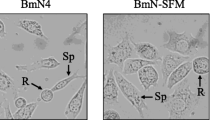Summary
The cell line UFL-AG-286 was established from the embryos ofAnticarsia gemmatalis (Lepidoptera: Noctuidae). The cell line was characterized by isozyme analysis and from molecular weight determination of the restriction endonuclease bands of the mitochondrial DNA. Cells seeded in 24-cluster wells had a doubling time of 5.9 d when seeded at 2×105 cells ml and 6.7 d when seeded at 3×105 cells/ml.
Similar content being viewed by others
References
Carner, G. R.; Turnipseed, S. G. Potential of a nuclear polyhedrosis virus for control of the velvetbean caterpillar in soybean. J. Econ. Entomol. 70:608–610; 1977.
Danyluk, G. M.; Maruniak, J. E. Characterization of insect cell lines using mitochondrial DNA restriction profiles and isozyme analysis. In Prep.
Gardiner, G. R.; Stockdale, H. Two tissue culture media for production of lepidopteran cells and nuclear polyhedrosis viruses. J. Invertebr. Pathol. 25:363–370; 1975.
Gazzoni, D.; de Oliveira, E. B.; Corso, I. C., et al. Manejo de pragas da soja. Circular Tecnica No. 5, Londrina: Empresa Brasileira de Pesquisa Agropecuaria. Centro Nacional de Pesquisa de Soja; 1981.
Granados, R. R.; Derksen, A. C. G.; Dwyer, K. G. Replication of theTrichoplusia ni granulosis and nuclear polyhedrosis viruses in cell cultures. Virology 152:472–476; 1986.
Greene, A. E.; Charney, J.; Nichols, W. W., et al. Species identity of insect cell lines. In Vitro 7:313–322; 1972.
Hink, W. F. Established insect cell line from the cabbage looper,Trichoplusia ni. Nature 266:466–467; 1970.
Johnson, D. W.; Silten, R. M.; Knudson, D. L., et al. Generation of nucleic acid fragment migration distances using a digitizer and microcomputers. Biotechnology Software 4:18–19; 1987.
Kurtti, T. J.; Brooks, M. A. Isolation of cell lines from embryos of the cockroach,Blattella germanica. In Vitro 13:11–17; 1977.
Kurtti, T. J.; Chaudhary, S. P. S.; Brooks, M. A. Influence of physical factors on the growth of insect cells in vitro. I. Effect of osmotic pressure on growth rate of a moth cell line. In Vitro 10:149–156; 1974.
Lynn, D. E.; Hung, A. C. F. Development of a continuous cell line from the insect egg parasitoid,Trichogramma pretiosum (Hymenoptera; Trichogrammatidae). In Vitro 22:440–442; 1986.
McIntosh, A. H.; Ignoffo, C. M. Characterization of five cell lines established from species ofHeliothis. Appl. Entomol. Zool. 18:262–269; 1983.
Miltenburger, H. G.; Naser, W. L.; Harvey, J. P., et al. The cellular substrate: a very important requirement for baculovirusin vitro replication. Z. Naturforsch. 39c:993–1002; 1984.
Moscardi, F.; Allen, G. E.; Greene, G. L. Control of the velvetbean caterpillar by nuclear polyhedrosis virus and insecticides and impact of treatments on the natural incidence of the entomopathogenic fungusNomuraea rileyi. J. Econ. Entomol. 74:480–485; 1981.
Rochford, R.; Dougherty, E. M.; Lynn, D. E. Establishment of a cell line from embryos of the cabbage looper,Trichoplusia ni (Hubner). In Vitro 20:823–825; 1984.
Sieburth, P. J.; Maruniak, J. E. Susceptibility of an established cell line ofAnticarsia gemmatalis (Lepidoptera: Noctuidae) to three nuclear polyhedrosis viruses. J. Invertebr. Pathol. In press.
Southern, E. M. Measurement of DNA length by gel electrophoresis. Anal. Bioch. 100:319–323; 1979.
Tapper, D. P.; van Etten, R. A.; Clayton, D. A. Isolation of mammalian mitochondrial DNA and RNA and cloning of the mitochondrial genome. In: Fleischer, S.; Fleischer, B., eds. Methods in enzymology, vol. 97. New York: Academic Press; 1983:426–434.
Turnipseed, S. G.; Kogan, M. Soybean entomology. Ann. Rev. Entomol. 21:247–282; 1976.
Vaughn, J. L. Insect cells for insect virus production. In: Maromorosch, K., ed. Advances in cell culture, vol. 1. New York: Academic Press; 1981:281–295.
Vaughn, J. L.; Goodwin, R. H.; Tompkins, G. J., et al. The establishment of two cell lines from the insectSpodoptera frugiperda (Lepidoptera; Noctuidae). In Vitro 13:213–217; 1977.
Author information
Authors and Affiliations
Additional information
This work was funded by U.S. Department of Agriculture grant 84-CRCR-1-1431. Florida Agricultural Experiment Station Journal Series, no. 8181.
Rights and permissions
About this article
Cite this article
Sieburth, P.J., Maruniak, J.E. Growth characteristics of a continuous cell line from the velvetbean caterpillar,Anticarsia gemmatalis Hübner (Lepidoptera: Noctuidae). In Vitro Cell Dev Biol 24, 195–198 (1988). https://doi.org/10.1007/BF02623546
Received:
Accepted:
Issue Date:
DOI: https://doi.org/10.1007/BF02623546




